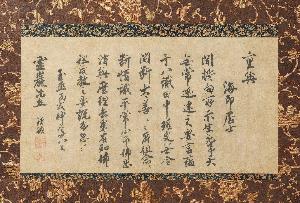Liaoan Qingyu
Liaoan Qingyu;Ryoan-Seiyoku
สถานที่: Taizhou
เกิด: 1288
ความตาย: 1363
ชีวประวัติ:
Liaoan Qingyu, also known as Ryoan-Seiyoku, was a Chan (Zen) monk and painter from China who lived during the Yuan dynasty (1279-1367). Born in 1288, Liaoan Qingyu was a disciple of the eminent monk Gulin Qingmou and served as the head monk at various temples including Baoning, Kaiyuan, and Benjue.
Early Life and Career
Liaoan Qingyu's early life and career are not well-documented, but it is known that he was a prominent figure in the Rinzai Zen tradition. He was heavily influenced by Chinese literati painting and calligraphy, which emphasized individual expression and personal interpretation over technical skill.
Artistic Style and Notable Works
Liaoan Qingyu's artistic style was characterized by simplicity, expressiveness, and a focus on meditation and intuition. His most notable work is the "Letter of Certification of Awakening", which he wrote in 1346. This letter is a prime example of his style, featuring bold brushstrokes and a minimalist composition. Some of Liaoan Qingyu's notable works can be found on Wikioo.org, including his paintings and calligraphy. His work is also featured in the Long Museum West Bund (Shanghai, China) and the Fukuoka Art Museum (Fukuoka, Japan).
Influence and Legacy
Liaoan Qingyu's influence on Chinese Zen Buddhism and art is still evident today. His emphasis on meditation, intuition, and simplicity has inspired many artists and collectors worldwide. The Boston Museum of Fine Arts and the Metropolitan Museum of Art feature extensive collections of Zen art, showcasing its enduring appeal and relevance.
- Zen Art Movement: Liaoan Qingyu was a key figure in the development of the Zen art movement, which emphasized meditation, intuition, and simplicity.
- Chinese Literati Painting: Liaoan Qingyu's work was heavily influenced by Chinese literati painting, which emphasized individual expression and personal interpretation over technical skill.
- Rinzai Zen Tradition: Liaoan Qingyu was a prominent figure in the Rinzai Zen tradition, which emphasized the importance of meditation and intuition in achieving enlightenment.
Liaoan Qingyu's biography can be found on Wikioo.org, along with his notable works and a detailed description of his artistic style. His legacy continues to inspire artists and collectors worldwide, and his work remains an important part of Chinese art history.

